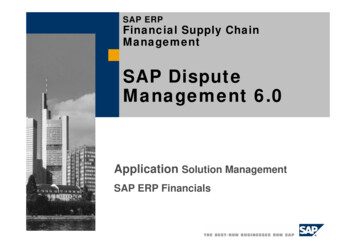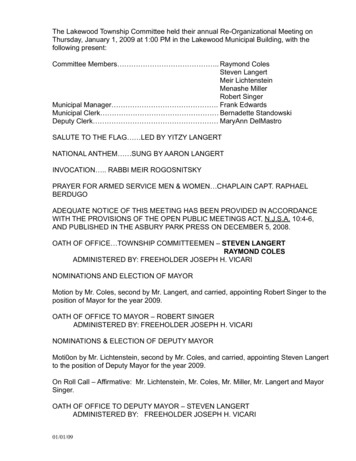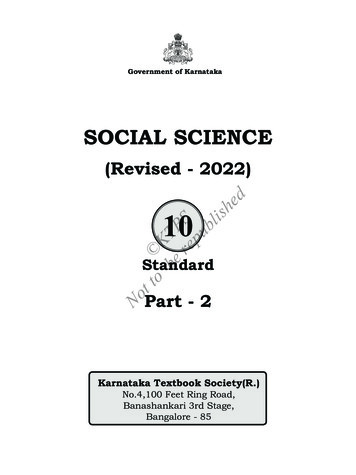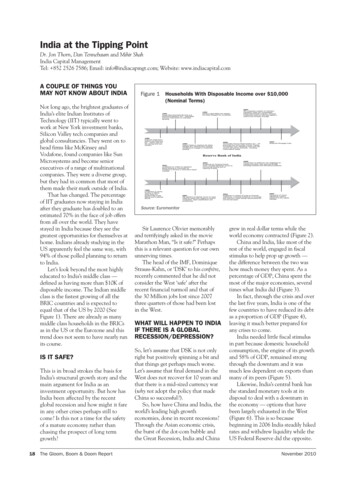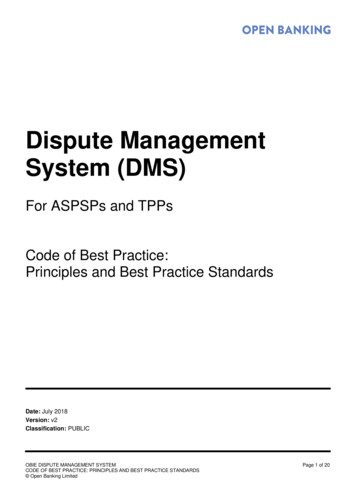
Transcription
1Alternative Dispute Resolution in IndiaA study on concepts, techniques, provisions, problems inimplementation and solutionsSubmitted to: Lok SattaSubmitted by: Nishita MedhaStudent, Ist year, IInd semesterNALSAR University of Law
2Table of ContentsChapterPage no.Acknowledgement03Introduction04Research methodology05Brief history of ADR06Overview of ADR08Elaborate explanation of ADR mechanisms10Study of ADR institutions across the world22Reasons behind introduction of ADR in India26The Arbitration and Conciliation Act, 199628Lok Adalats as a unique ADR measure in India38Implementation of ADR in India42Conclusion52Bibliography53
3Acknowledgement:I am highly grateful to Dr. Jayaprakash Narayan for giving interns an opportunity to work in apublic-oriented organization like Lok Satta. The experience gained at Lok Satta in researching ona topic relevant to the present times has helped me in enriching my knowledge base. I thank Mr.Sanjay, Ms. Shobana and Ms. Fatima who have given me all the necessary support andencouragement to do this project.
4Introduction:Gandhiji said: "I had learnt the true practice of law. I had learnt to find out the better side ofhuman nature, and to enter men's hearts. I realized that the true function of a lawyer was to uniteparties given as under. The lesson was so indelibly burnt unto me that the large part of my time,during the twenty years of my practice as a lawyer, was occupied in bringing about privatecompromises of hundreds of cases. I lost nothing, thereby not even money, certainly not mysoul." 1Conflict is a fact of life. It is not good or bad. However, what is important is how we manage orhandle it. Negotiation techniques are often central to resolving conflict and as a basic techniquethese have been around for many thousands of years. Alternative Dispute Resolution (ADR)refers to a variety of streamlined resolution techniques designed to resolve issues in controversymore efficiently when the normal negotiation process fails. Alternative Dispute Resolution(ADR) is an alternative to the Formal Legal System. It is an alternative to litigation. It was beingthought of in view of the fact that the Courts are over burdened with cases. The said systememanates from dissatisfaction of many people with the way in which disputes are traditionallyresolved resulting in criticism of the Courts, the legal profession and sometimes lead to a senseof alienation from the whole legal system- thus, the need for Alternative Dispute Resolution.With the spread of ADR programs in the developed and developing world, creative uses for anddesigns for ADR systems are proliferating. Successful programs are improving the lives ofindividuals and meeting broad societal goals. There is a critical mass of ADR experience,revealing important lessons as to whether, when and how to implement ADR projects.It is against this backdrop, that this research paper intends to discuss the various ADRmechanisms, the provisions present in India and the World over, and its peculiarity,implementation and problems in the Indian context. The various remedies to the situation havealso been s/2002v1a3.htm
5Research methodology:The research methodology adopted for the purpose of this project is the doctrinal method ofresearch. The various library and Internet facilities available at Lok Satta and NALSARUniversity of Law have been utilized for this purpose. Most of the information is, however, fromthe Internet.
6Brief History of ADRADR originated in the USA in a drive to find alternatives to the traditional legal system, felt tobe adversarial, costly, unpredictable, rigid, over-professionalised, damaging to relationships, andlimited to narrow rights-based remedies as opposed to creative problem solving. The Americanorigins of the concept are not surprising, given certain features of litigation in that system, suchas: trials of civil actions by a jury, lawyers' contingency fees, lack of application in full of therule "the loser pays the costs".Beginning in the late nineteenth century, creative efforts to develop the use of arbitration andmediation emerged in response to the disruptive conflicts between labor and management. In1898, Congress followed initiatives that began a few years earlier in Massachusetts and NewYork and authorized mediation for collective bargaining disputes. In the ensuing years, specialmediation agencies, such as the Board of Mediation and Conciliation for railway labor, (1913)(renamed the National Mediation Board in 1943), and the Federal Mediation and ConciliationService (1947) were formed and funded to carry out the mediation of collective bargainingdisputes. Additional state labor mediation services followed. The 1913 New lands Act and laterlegislation reflected the belief that stable industrial peace could be achieved through thesettlement of collective bargaining disputes; settlement in turn could be advanced throughconciliation, mediation, and voluntary arbitration.2At about the same time, and for different reasons, varied forms of mediation for non-labormatters were introduced in the courts. When a group of lawyers and jurists spoke on the topic toan American Bar Association meeting in 1923, they were able to assess court-related conciliationprograms in Cleveland, Minneapolis, North Dakota, New York City, and Milwaukee.Conciliation in a different form also appeared in domestic relations courts. An outgrowth ofconcern about rising divorce rates in the postwar 1940's and the 1950's, the primary goal of theseprograms was to reduce the number of divorces by requiring efforts at reconciliation rather ourt/ADR/ADR/adr history.htm
7to facilitate the achievement of divorces through less adversarial proceedings. Followingprivately funded mediation efforts by the American Arbitration Association and others in the late1960s, the Community Relations Service (CRS) of the United States Department of Justiceinitiated in 1972 a mediation program for civil rights disputes.Although a small number of individual lawyers had been interested in and were practicingmediation ADR in Britain for some years, it was only in 1989 when the first British based ADRcompany - IDR Europe Ltd. - bought the idea across the Atlantic and opened its doors forbusiness. This was the start of ADR Group. Since then many other ADR organizations, includingCEDR (Centre for Dispute Resolution), followed suite and assisted in the development andpromotion of ADR in the UK.3ADR, or mediation (as it is now synonymously known as), is used world-wide by Governments,corporations and individuals to resolve disputes big or small, of virtually any nature and in mostcountries of the world.In developing countries where most people opt for litigation to resolve disputes, there isexcessive over-burdening of courts and a large number of pending cases, which has ultimatelylead to dissatisfaction among people regarding the judicial system and its ability to dispensejustice. This opinion is generated largely on the basis of the popular belief, “Justice delayed isjustice denied”. However, the blame for the large number of pending cases in these developingcountries or docket explosion, as it is called, cannot be attributed to the Courts alone. The reasonfor it being the non-implementation of negotiation processes before litigation. It is against thisbackdrop that the mechanisms of Alternative Dispute Resolution are being introduced in thesecountries. These mechanisms, which have been working effectively in providing an amicable andspeedy solution for conflicts in developed economies, are being suitably amended andincorporated in the developing countries in order to strengthen the judicial system. Manycountries such as India, Bangladesh and Sri Lanka have adopted the Alternative DisputeResolution Mechanism. However, it is for time to see how effective the implementation of thesemechanisms would be in these countries.3http://www.adrgroup.co.uk/history.html
8Overview of ADR:Alternative dispute resolution encompasses a range of means to resolve conflicts short of formallitigation. The modern ADR movement originated in the United States in the 1970s, spurred by adesire to avoid the cost, delay, and adversarial nature of litigation. For these and other reasons,court reformers are seeking to foster its use in developing nations. The interest in ADR in somecountries also stems from a desire to revive and reform traditional mediation mechanisms.ADR today falls into two broad categories: court-annexed options and community-based disputeresolution mechanisms. Court-annexed ADR includes mediation/conciliation—the classicmethod where a neutral third party assists disputants in reaching a mutually acceptablesolution—as well as variations of early neutral evaluation, a summary jury trial, a mini-trial, andother techniques. Supporters argue that such methods decrease the cost and time of litigation,improving access to justice and reducing court backlog, while at the same time preservingimportant social relationships for disputants.4Community-based ADR is often designed to be independent of a formal court system that maybe biased, expensive, distant, or otherwise inaccessible to a population. New initiativessometimes build on traditional models of popular justice that relied on elders, religious leaders,or other community figures to help resolve conflict. India embraced lok adalat village-levelpeople’s courts in the 1980s, where trained mediators sought to resolve common problems that inan earlier period may have gone to the panchayat, a council of village or caste elders. Elsewherein the region, bilateral donors have recently supported village-based shalish mediation inBangladesh and nationally established mediation boards in Sri Lanka. In Latin America, therehas been a revival of interest in the juece de paz, a legal officer with the power to conciliate ormediate small claims.Some definitions of ADR also include commercial arbitration: private adversarial proceedings inwhich a neutral third party issues a binding decision. Private arbitration services and centers havean established role in the United States for commercial dispute resolution, and are spreadinginternationally as business, and the demand for harmonization, expands. In the last decade, ADR%20Workshop.pdf
9countries have passed legislation based on the 1985 UNCITRAL Model Law on InternationalCommercial Arbitration, which makes an arbitral award legally binding and grants broad rightsto commercial parties choosing arbitration.It is important to distinguish between binding and non-binding forms of ADR. Negotiation,mediation and conciliation are non-binding forms, and depend on the willingness of parties toreach a voluntary agreement. Arbitration programs may be binding or non-binding. BindingArbitration produces a third party decision that the disputants must follow even if they disagreewith the result much like a judicial decision. Non-binding Arbitration produces a third partydecision that the parties may reject.It is also important to distinguish between mandatory processes and voluntary processes. Somejudicial systems require the parties to negotiate, conciliate, mediate or arbitrate, prior to courtaction. ADR processes may also be required as part of prior contractual agreement betweenparties. In voluntary processes, submission of a dispute to an ADR process depends entirely onthe will of the parties.These forms of ADR along with a lot of other hybrid processes are discussed in the next chapterof the paper. Therefore, it can observed that the term “Alternative dispute resolution” can refer toeverything from facilitated settlement negotiations in which disputants are encouraged tonegotiate directly with each other, prior to some other legal process, to arbitration systems ormini-trials that look and feel very much like a courtroom process. Processes designed to managecommunity tension or facilitate community development issues can also be included into therubric of ADR.
10Elaborate explanation of the various kinds of ADR mechanisms:a) Arbitration: Arbitration, in the law, is a form of alternative dispute resolution —specifically, a legal alternative to litigation whereby the parties to a dispute agree to submit theirrespective positions (through agreement or hearing) to a neutral third party (the arbitrator(s) orarbiter(s)) for resolution.5Species of arbitrationi)Commercial arbitration:Agreements to arbitrate were not enforceable at commonlaw, though an arbitrator's judgment was usually enforceable (once the parties hadalready submitted the case to him or her). During the Industrial Revolution, thissituation became intolerable for large corporations. They argued that too manyvaluable business relationships were being destroyed through years of expensiveadversarial litigation, in courts whose strange rules differed significantly from theinformal norms and conventions of business people (the private law of commerce, orjus merchant). Arbitration appeared to be faster, less adversarial, and cheaper. Sincecommercial arbitration is based upon either contract law or the law of treaties, theagreement between the parties to submit their dispute to arbitration is a legallybinding contract. All arbitral decisions are considered to be "final and binding." Thisdoes not, however, void the requirements of law. Any dispute not excluded fromarbitration by virtue of law (e.g. criminal proceedings) may be submitted toarbitration.6ii)Other forms of Contract Arbitration: Arbitration can be carried out betweenprivate individuals, between states, or between states and private individuals. In thecase of arbitration between states, or between states and individuals, the PermanentCourt of Arbitration and the International Center for the Settlement of onIbid
11Disputes (ICSID) are the predominant organizations. Arbitration is also used as partof the dispute settlement process under the WTO Dispute Settlement Understanding.International arbitral bodies for cases between private persons also exist, theInternational Chamber of Commerce Court of Arbitration being the most important.The American Arbitration Association is a popular arbitral body in the United States.Arbitration also exists in international sport through the Court of Arbitration forSport.iii)Labor Arbitration: A growing trend among employers whose employees are notrepresented by a labor union is to establish an organizational problem-solvingprocess, the final step of which consists of arbitration of the issue at point by anindependent arbitrator, to resolve employee complaints concerning application ofemployer policies or claims of employee misconduct. Employers in the United Stateshave also embraced arbitration as an alternative to litigation of employees' statutoryclaims, e.g., claims of discrimination, and common law claims, e.g., claims ofdefamation. Arbitration has also been used as a means of resolving labor disputes formore than a century. Labor organizations in the United States, such as the NationalLabor Union, called for arbitration as early as 1866 as an alternative to strikes toresolve disputes over the wages, benefits and other rights that workers would enjoy.Governments have also relied on arbitration to resolve particularly large labordisputes, such as the Coal Strike of 1902. This type of arbitration is commonly knownas interest arbitration, since it involves the mediation of the disputing parties'demands, rather than the disposition of a claim in the manner a court would act.Interest arbitration is still frequently used in the construction industry to resolvecollective bargaining disputes.Unions and employers have also employed arbitrationto resolve employee grievances arising under a collective bargaining agreement.77Supra n. 5
12iv)Judicial Arbitration: Some state court systems have promulged court-orderedarbitration; family law (particularly child custody) is the most prominent example.Judicial arbitration is often merely advisory, serving as the first step towardresolution, but not binding either side and allowing for trial de novo.v)Proceedings: Various bodies of rules have been developed that can be used forarbitration proceedings. The two of the most important are the UNCITRAL rules andthe ICSID rules. The general rules to be followed by the arbitrator are specified by theagreement establishing the arbitration. Some jurisdictions have instituted a limitedgrace period during which an arbitral decision may be appealed against, but afterwhich there can be no appeal. In the case of arbitration under international law, aright of appeal does not in general exist, although one may be provided for by thearbitration agreement, provided a court exists capable of hearing the appeal.vi)Arbitrators: Arbitrators are not bound by precedent and have great leeway in suchmatters as active participation in the proceedings, accepting evidence, questioningwitnesses, and deciding appropriate remedies. Arbitrators may visit sites outside thehearing room, call expert witnesses, seek out additional evidence, decide whether ornot the parties may be represented by legal counsel, and perform many other actionsnot normally within the purview of a court. It is this great flexibility of action,combined with costs usually far below those of traditional litigation, which makesarbitration so attractive. Arbitrators have wide latitude in crafting remedies in thearbitral decision, with the only real limitation being that they may not exceed thelimits of their authority in their award. An example of exceeding arbitral authoritymight be awarding one party to a dispute the personal automobile of the other partywhen the dispute concerns the specific performance of a business-related contract. Itis open to the parties to restrict the possible awards that the abitrator can make. If thisrestriction requires a straight choice between the position of one party or the position
13of the other, then it is known as pendulum arbitration or final offer arbitration. It isdesigned to encourage the parties to moderate their initial positions so as to make itmore likely they receive a favourable decision. To ensure effective arbitration and toincrease the general credibility of the arbitral process, arbitrators will sometimes sit asa panel, usually consisting of three arbitrators. Often the three consist of an expert inthe legal area within which the dispute falls (such as contract law in the case of adispute over the terms and conditions of a contract), an expert in the industry withinwhich the dispute falls (such as the construction industry, in the case of a disputebetween a homeowner and his general contractor), and an experienced arbitrator.vii)Some important statistics : Use and effectiveness of Arbitration as a mechanismof ADR: American case study (source: National Arbitration Forum, Washington)
14Key Findings in the above survey:78% of people find faster recovery in Arbitration83% of people find Arbitration equally or more fair59.3% of people find Arbitration less expensive84.6% of people find ADR equally or more suitable for insurance/reinsurance sector8Another survey:This survey clearly shows the increase in the number of people over the years whowould opt for Arbitration over a lawsuit for the recovery of monetary damages.8http://www.icadr.org/news-speechcjhc.html
15Therefore, it is obvious that Arbitration is a growing field with a lot of potential insolving disputes in a speedy manner.b) Mediation: Mediation is a process of alternative dispute resolution in which a neutral thirdparty, the mediator, assists two or more parties in order to help them negotiate an agreement,with concrete effects, on a matter of common interest; lato sensu is any activity in which anagreement on whatever matter is researched by an impartial third party, usually a professional, inthe common interest of the parties. i) Types of Disputes resolved by mediation:9AviationBanking and financeBoundary DisputesBroker LiabilityBusiness DisputesCharitiesClinical & Medical Negligence Competition9Commercial agenciesCommercial contractsConstruction & DevelopmentCorporate financeDistribution agreementsEmploymentEnergyEngineering & Manufacturing DisputesEnvironmental issuesFinancial ServicesFranchisesGroup/Class actionsInformation TechnologyInsolvency and BankruptcyInsurance & ReinsuranceIntellectual Property, Trade Mark and CopyrightLandlord & TenantLeasing & Supply ContractsLender LiabilityLibel & DefamationMaritime & ShippingMultiparty actionsNeighbour DisputesNuisanceOil & Gas ContractsPartnership DisputesPassing-off ActionsPensionsPersonal InjuryPollution ClaimsProduct LiabilityPersonal Indemnityhttp://www.adrgroup.co.uk/types.html
16Property & Real EstatePublishing, Television & Broadcasting RightsRailway Industry, TransportRegulatory DisputesSecurities & SharesShareholder’s Disputesii) Stages of Mediation10: Mediation commonly includes the following aspects orstages: a controversy, dispute or difference of positions between people, or a need for decisionmaking or problem-solving; decision-making remaining in the parties rather than being made by the neutral; the willingness of the parties to negotiate a positive solution to their problem and toaccept a discussion about respective interests and objectives; the intent to achieve a positive result through the facilitative help of an independent andneutral third person.The typical mediation has no formal compulsory elements, although some commonelements are usually found: Each party having a chance to tell his or her story; Identification of issues, usually by the mediator; The clarification and detailed specification of the respective interests and objectives, the conversion of respective subjective evaluations into more objective values, Identification of options; Discussion and analysis of the possible effects of various solutions; the adjustment and the refining of the accessory aspects, memorializing the agreements into a written draftDue to the particular character of this activity, each mediator uses a method of his or herown (a mediator's methods are not ordinarily governed by law), that might eventually dr.htm
17very different from the above scheme. Also, many matters do not legally require aparticular form for the final agreement, while others expressly require a preciselydetermined form. Most countries respect a Mediator’s confidentiality. Mediation differsthe most from other adversarial resolution processes by virtue of its simplicity,informality, flexibility and economy.iii) Mediation in Business and Commerce: The eldest branch of mediation appliesto business and commerce, and still this one is the widest field of application, withreference to the number of mediators in these activities and to the economical range oftotal exchanged values. The mediator in business or in commerce helps the parties toachieve the final goal of respectively buying/selling (a generical contreposition thatincludes all the possible varieties of the exchange of goods or rights) something atsatisfactory conditions (typically in the aim of producing a synallagmatic contract),harmonically bringing the separate elements of the treaty to a respectively balancedequilibrium. The mediator, in the ordinary practice, usually cares of finding a positiveagreement between (or among) the parties looking at the main pact as well as at theaccessory pacts too, thus finding a composition of all the related aspects that mightcombine in the best possible way all the desiderata of his clients. The subfields includespecialised branches that are very well commonly known: in finance, in insurances, inship-brokering, in real estate and in some other particular markets, mediators have anown name and usually obey to special laws. Generally the mediator cannot practicecommerce in the genre of goods in which he is a specialised mediator.iv) Global Relevance: The rise of international trade law, continental trading blocs,the World Trade Organization and its opposing anti-globalization movement, use of theinternet, among other factors, seem to suggest that legal complexity is rising to anintolerable and undesirable point. There may be no obvious way to determine whichjurisdiction has precedence over which other, and there may be substantial resistance tosettling a matter in any one place. Accordingly, mediation may come into morewidespread use, replacing formal legal and judicial processes sanctified by nation-states.Some, like the anti-globalization movement, believe that such formal processes have
18quite thoroughly failed to provide real safety and closure guarantees that are pre-requisiteto uniform rule of law. Following an increasing notoriety of the process, and a widernotion of its main aspects and eventual effects, mediation is in recent times frequentlyproposed as a form of resolution of international disputes, with attention to belligerentsituations too.c) Conciliation: Conciliation is an alternative dispute resolution process whereby the parties toa dispute (including future interest disputes) agree to utilize the services of a conciliator, whothen meets with the parties separately in an attempt to resolve their differences. Conciliationdiffers from arbitration in that the conciliation process, in and of itself, has no legal standing, andthe conciliator usually has no authority to seek evidence or call witnesses, usually writes nodecision, and makes no award. Conciliation differs from mediation in that the main goal is toconciliate, most of the time by seeking concessions. In mediation, the mediator tries to guide thediscussion in a way that optimizes parties needs, takes feelings into account and reframesrepresentations. In conciliation the parties seldom, if ever, actually face each other across thetable in the presence of the conciliator. (This latter difference can be regarded as one of speciesto genus. Most practicing mediators refer to the practice of meeting with the parties separately as"caucusing" and would regard conciliation as a specific type or form of mediation practice -"shuttle diplomacy" -- that relies on exclusively on caucusing. All the other features ofconciliation are found in mediation as well.) If the conciliator is successful in negotiating anunderstanding between the parties, said understanding is almost always committed to writing(usually with the assistance of legal counsel) and signed by the parties, at which time it becomesa legally binding contract and falls under contract law.11A conciliator assists each of the parties to independently develop a list of all of their objectives(the outcomes which they desire to obtain from the conciliation). The conciliator then has each ofthe parties separately prioritize their own list from most to least important. She then goes backand forth between the parties and encourages them to "give" on the objectives one at a time,starting with the least important and working toward the most important for each party in turn.The parties rarely place the same priorities on all objectives, and usually have some ion
19which are not on the list compiled by parties on the other side. Thus the conciliator can quicklybuild a string of successes and help the parties create an atmosphere of trust which the conciliatorcan continue to develop.d)Expert Determination: Expert determination is a historically accepted form of disputeresolution invoked when there isn't a formulated dispute in which the parties have definedpositions that need to be subjected to arbitration, but rather both parties are in agreement thatthere is a need for an evaluation, e.g. in a preceding contract. The practise itself is millennia oldand well established where complex legal institutions either have not developed, or areunavailable, such as tribal societies and criminal organisations.The first mention thatdistinguishes specifically against the practise of arbitration, and introduces the formula "as anexpert and not as an arbitrator" was in Dean v. Prince 1953 Ch. 590 at 591 (misquoted) andsubsequently on appeal in the year 1954 1 Ch. 409 at 415.12e) Negotiation: Negotiation is the process whereby interested parties resolve disputes, agreeupon courses of action, bargain for individual or collective advantage, and/or attempt to craftoutcomes which serve their mutual interests. It is usually regarded as a form of alternativedispute resolution.Given this definition, one can see negotiation occurring in almost all walks oflife, from parenting to the courtroom.13In the advocacy approach, a skilled negotiator usually serves as advocate for one party to thenegotiation and attempts to obtain the most favorable outcomes possible for that party. In thisprocess the negotiator attempts to determine the minimum outcome(s) the other party is (orparties are) willing to accept, then adjusts her demands accordingly. A "successful" negotiationin the advocacy approach is when the negotiator is able to obtain all or most of the outcomes hisparty desires, but without driving the other party to permanently break off negotiations.Traditional negotiating is sometimes called win-lose because of the hard-ball style of thenegotiators whose motive is to get as much as they can for their side. In the Seventies,practitioners and researchers began to develop win-win approaches to negotiation. This approach,12http://en.wikipedia.org/wiki/Expert ation
20referred to as Principled Negotiation, is also sometimes called mutual gains bargaining. Themutual gains approach has been effectively applied in environment
6 Brief History of ADR ADR originated in the USA in a drive to find alternatives to the traditional legal system, felt to be adversarial, costly, unpredictable, rigid, over-professionalised, damaging to relationships, and
